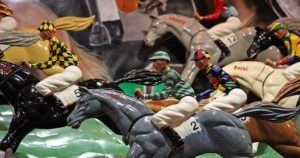What is a ‘Pattern’ race?
A ‘Pattern’ race is a horse race that is assigned Group One, Group Two or Group Three status, on the Flat, or Grade One, Grade Two or Grade Three status, in National Hunt racing. In both cases, these races represent the highest tiers, in terms of quality, prestige and value, but are ranked by two different bodies, with the power to upgrade or downgrade races from one season to the next.
On the Flat, ‘Group’ status, which is only awarded to non-handicap races of sufficient calibre, is assigned by the European Pattern Committee. The European Pattern Race system, which regulates so-called ‘black type’ races in France and Germany as well as in Britain and Ireland, was introduced in 1971. At that time, Pattern races were structured, in order of importance, as major international races, minor international races and major domestic races.
In National Hunt racing, the Jump Pattern Committee performs a similar function to the European Pattern Committee, but operates under the auspices of the British Horseracing Authority (BHA) and, as such, covers Britain alone. The National Hunt Pattern actually pre-dates the European Pattern Race system by two years, but was revised by the forerunner of the BHA, the Jockey Club, in 1989, to create the basis of the current system. The National Hunt Pattern includes several high-profile handicap races, not least the Grand National.
 A maiden race is a race for, well, maidens or, in other words, a race in which none of the participants has won a race in its selected discipline. The key phrase here is ‘in its selected discipline’, because a horse that has won a race in one discipline may still be eligible to run in maiden races in another. A horse that has won on the Flat, including under National Hunt Rules, for example, remains eligible for maiden races over hurdles, or fences for that matter, until such a time as it wins a race over one type of obstacle or the other.
A maiden race is a race for, well, maidens or, in other words, a race in which none of the participants has won a race in its selected discipline. The key phrase here is ‘in its selected discipline’, because a horse that has won a race in one discipline may still be eligible to run in maiden races in another. A horse that has won on the Flat, including under National Hunt Rules, for example, remains eligible for maiden races over hurdles, or fences for that matter, until such a time as it wins a race over one type of obstacle or the other.